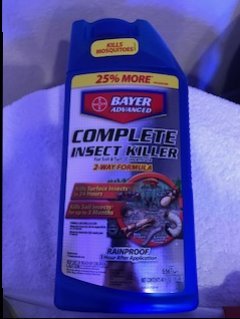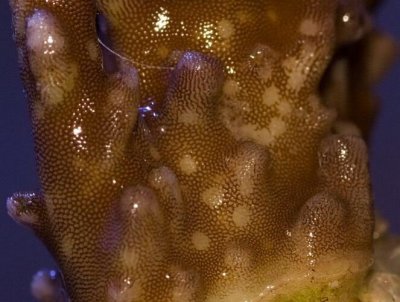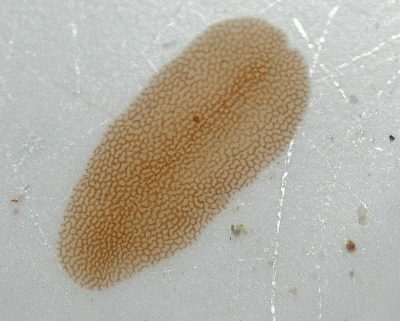For those who are unaware, there is an alternative dipping method out there using Bayer Advanced Complete Insect Killer for Turf and Soil Concentrate. It has been heralded as a more gentle alternative to things like Revive and Coral RX, yet just as effective. I myself have used this in combination with Coral RX at times (not in the same container but one after the other). But to date I have not had any coral come in with AEFW so I have been unable to truly test it myself. There are several threads out there where some have done a bit of testing, and just as many more telling you methods on how to use it.
This weekend that all changed. I had someone contact me locally that said he found bite marks on one of his coral. If you haven't seen AEFW bite marks, here is an image from another thread here on R2R. It looks pretty much just as you'd expect. Like someone is making an acropora sandwich from the skin of your beloved coral.
I went to his house, Bayer in hand, and took a look at the coral. Fortunately for him it was in his QT tank. He generally follows the advice to QT a coral after it arrives, then 1 week later do the dip. This is actually what I would recommend as well. When a coral arrives to you from being shipped it is already stressed. Dipping it can be a double whammy for the coral. The only time I make exception to this is if I already have something in QT. But there really is no wrong or right way so long as you follow a strict QT process.
Sure enough there were bite marks, and I could see at least 5 AEFW upon closer inspection. We put the coral into a container with tank water and blasted it. It turned up 6 AEFW at the bottom of the container. It should be noted that not all AEFW can be so easily removed, depending on how far they have their mouths dug into the coral, simply blasting will not remove them.
He decided to toss the coral to be safe, which isn't a bad way to go as you never know what eggs you might not see inside way up under the skeleton of the coral. In addition, when they do hatch, they can go up inside and burrow into the skeleton of the coral, burying themselves in such a way that they may be immune to dips until they are too large to remain inside the coral skeleton. In other words:
Anyways, on to the test! I did 3 different doses of Bayer in this test. Each used 1/2 cup of water and had two of the AEFW. I added 5ml, 10ml, and 15ml to the 3 different containers. It was then stirred and let to sit with occasional stirring for 10 minutes. After the 10 minutes, we dumped the container onto a mesh to catch the AEFW and we then put them into normal tank water again to see what happened. Here are the results!
The 5ml container - after the 10 minutes the AEFW were still alive! They seemed pretty agitated but after 30 minutes of sitting in the salt water they were fairly normal looking again. So, 5ml per 1/2 cup is NOT enough in my opinion.
The 10ml container - this is the "standard" dose that I have seen mentioned in many threads. After 10 minutes the AEFW were put back into tank water and we thought it had done the trick. They weren't moving and looked dead as a door nail. But, this was NOT the case! After about 15 minutes they began to move again. This honestly surprised me. I had heard of someone else seeing this happen as well, but seeing it myself was still a bit unnerving. After another 15 minutes they seemed to be fairly normal, albeit still a bit agitated. So, to me, 10ml per 1/2 cup is NOT enough!
The 15ml container - after 10 minutes in the milky bath of Bayer, these AEFW never moved again. We left them in the container for 60 minutes to be sure, and not a single sign of life. This seems to do the trick with the AEFW. Dead - just the way we want it.
For me, I have always used 15-20ml per half cup of water as I have read previous experiences on the issue. The coral always seem to recover quickly, so it doesn't appear to be too harsh on them. Have you done similar tests? Share your results!















